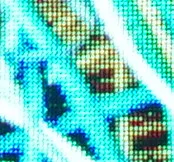This week has been one of those that makes having a front page something of a problem. As I’ve said before, putting something on the front page makes it important, and that was what we’re faced with this week.
I’ve had another week travelling, in Germany this time and I visited Karlsruhe in the South East of the country to give a talk to the Deutsches Flachdisplay Forum on the recent SID and Infocomm shows. I also took the chance to catch up with some of our market research clients. One of the topics that came up several times was fine pitch LED displays for indoor use. As we reported from the Display Summit, the cost of 3.5mm discrete LED walls has now reached the same level as good quality ultra-narrow bezel LCDs on a price per square metre/ft basis. That makes them interesting competitors.
So how do LCD and LED compare? Well, at the Display Summit, there was a demonstration of a Panasonic video wall next to an NEC LCD video wall. Both displays were well set up and came from professional companies. The floor had been marked and delegates at the event were encouraged to look at both from different distances.
At further distances, the Panasonic video wall looked a lot better than the LCD. The LEDs in video walls are embedded in black substrates that give a very good black and, of course, as an emissive display, an LED can be completely powered off. Equally, the LED display had high brightness, so the contrast was compelling.
As you got closer, there were two different effects. Walking towards the displays along a line perpendicular from a point between them, the brightness and contrast of the LED stayed the same, but the reduction in contrast of the LCD as the viewing angle got more oblique became more apparent and the LED looked better and better in comparison.
However, the second factor that came into play was “fill factor”, that is, the percentage of the area of the pixel that is bright when it is illuminated. In LED displays, the fill factor is small – that is to say, the bright part of the pixel is only a small part of the whole thing. This is partly because of economics.
LEDs are semiconductors and like other chips, they are made on wafers. Processing a wafer has a fairly fixed cost for a particular size of wafer. The smaller you can make the LED, then the more you can cut from a single wafer. Given that you need six million LEDs to make a full HD display, saving cost on each one is a big priority, so the LED devices are as small as possible, and surrounded by a big black border.
This small sample of an image from a Leyard 0.7mm LED shows the fill factor issueWhen you are far enough away from an LED display, the blurring in your vision diffuses the light from the point source of the LED to cover the whole pixel. In the past, it used to be said that you needed to be the same number of metres away as the pixel pitch, i.e. 3 metres for a 3mm pitch, but LEDs have got more efficient and smaller, and now I think that is not far enough. But when you are close, the black background is quite unpleasant, especially against the very bright LED “point source”.
Of course, you could use some kind of diffuser or optics to fix this problem, but that would either reduce the efficiency or start to cause the kinds of viewing angle issues that LCDs suffer from.
When you get close to the LCD, you don’t get this effect. That means in any application where you expect the viewer to get close to the display, the LCD will look better, even when the pitch is the same and very small e.g. 0.7mm.
However, for big video walls, seen from a distance, the writing is on the wall (pun intended) for LCD video walls.
That is particularly interesting because LED is really a Chinese industry these days. Probably 90% of the video wall production is in China – maybe more, even if there is a Western or Japanese brand that is the final supplier. Further, China is investing heavily in LEDs for lighting applications which will continue to drive the technology on and the cost down. – Bob

